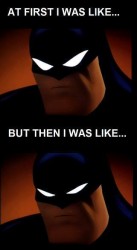I try not to read internet rumors. Most of the time they just get me riled about something dreamed up by someone on a message board. Unfortunately, this means that sometimes I get bad news in public places. That can be unpleasant. A few weeks ago in a comics shop, some friends told me that Birds of Prey was getting cancelled. I won’t get into details, but there was loud wailing involved. Loud, sustained wailing.
I’ve written about how the Wonder Woman mythos doesn’t do much for me. Birds of Prey was my version of Amazon Island. Up until Canary left, it was a long-preserved team. It was all-girl, all bad-ass, all the time. Since it was not one of the hottest-selling books it was a sheltered island, out of the way of the major continuity events, where some of the lesser known female characters could thrive.
Yes, I know that there is going to be an Oracle mini-series, and while Barbara Gordon is one of my top five characters of all time, I’m going to miss the rest of the Birds. Canary was at her best with a team that she could have fun with, not fight with or mother. Huntress was an awkward fit everywhere else in the DCU, too independent to be one of the bats, too bat-oriented to get away from them. In Birds of Prey she got a chance to shine, and take control. And of course there’s Zinda, who is one of the most fun characters in the DCU. There’s Manhunter, who had her own book cancelled recently. Even Misfit was growing on me.
When a favorite character of mine loses a book, I always wonder if I’ll see them again. Being too unpopular for a book, but just popular enough to be noticed, is often a recipe for death when big events come up. I feel like Daniel Day-Lewis in Last of the Mohicans. “Stay alive, no matter what occurs! I will find you!”
I also mourned the end of The Blue Beetle, but at least I know that Jaime will be preserved in Teen Titans. Also, I think that, as stages of grief go, I am still firmly routed in ‘denial.’ Jaime will come back. I know this. He must.
Birds of Prey has catapulted me into ‘bargaining.’ What would it take to get the Birds back. How would it be possible to drive up readership? Let me rephrase that. How would it be possible to drive up readership besides having a Babs, Dinah, and Helena three-way in each book? (Yeah, I’ve seen that fanart.)
As the saying goes, when all you have is a hammer, everything looks like a nail. What I have is a steadfast love of comics that are light, fun, and just a little nutzo. My ideal Birds book would be a cross between the early Indiana Jones movies and Bruce Lee on pixie stix. Three-to-five issue arcs, each one being a separate adventure. Fast, fun, and ass-kicking. I’d like constant wisecracks, mild indignity, ninja stuff, at least two issues in which people run to get out of the way of giant boulders, and Misfit as Short Round. That’s Short Round, not Mutt. Sorry, Shia.
I think the book was doing best with its four core characters; Babs, Helena, Dinah, and Zinda. As said before, Misfit could be Short Round. And, of course, since Indy got a new girl every movie, there could be a rotating spot for the last member to keep things fresh.
But hell, I’d favor an eighteen-person team in a somber, noirish book comprised of thirty-issue all-event storyarcs if I thought I’d be getting my Birds back.
What would you hope for in a Birds book?


